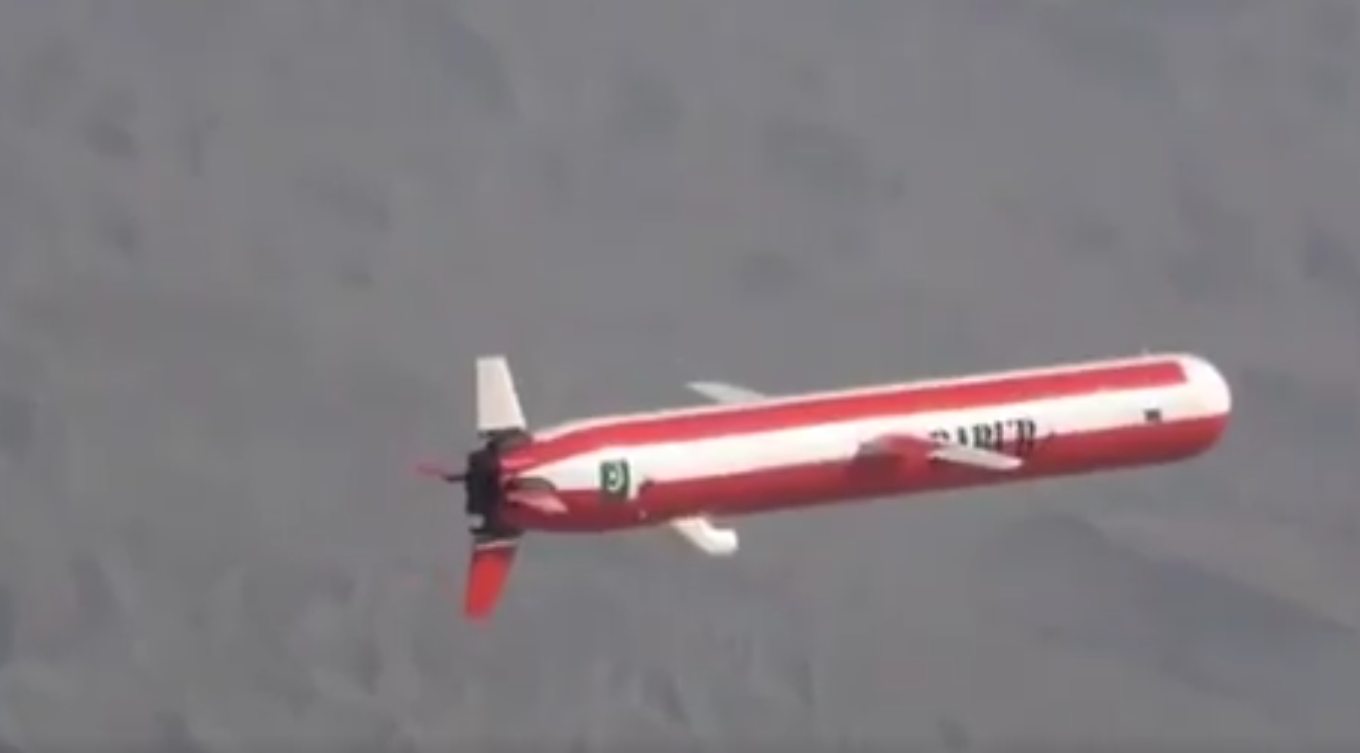2483Views 19Comments

Pakistan successfully tests ‘Babur Version-2’ cruise missile
Pakistan’s Strategic Plans Division test fired the Babur Version-2 land-attack cruise missile (LACM), an improved variant of the Babur incorporating “advanced aerodynamics and avionics” on Wednesday, 14 December.
As per Inter-Services Public Relations (ISPR), the Babur Version-2 LACM possesses a range of 700 km and is capable of striking targets on land and at sea.
Capable of low-altitude flight and terrain-hugging, the Babur Version-2’s guidance suite is composed of Terrain Contour Matching (TERCOM) and Digital Scene-Mapping Area Correlator (DSMAC).
Notes & Comments:
The Hatf (Vengeance) VII Babur was developed as an analogous solution to the BGM-109 Tomahawk, the U.S.’ mainstay LACM. The Babur is powered by a micro-turbofan or turbojet (unconfirmed) engine which is enables the Babur to fly at sub-sonic speed.
The Babur/Version-2’s TERCOM and DSMAC guidance systems enable the it to accurately engage targets without satellite-navigation support (the required target location information is stored within the missile. DSMAC serves as an optical sensor to match real-time imagery with stored imagery information).
The Babur-series is an essential component to Pakistan’s deterrence strategy. Like the Ra’ad air-launched cruise missile (ALCM) and Nasr tactical ballistic missile, the Babur enables the Pakistani military to launch nuclear warheads using munitions that could be deployed through a wide range of platforms, such as the combat aircraft and, potentially, submarines.
While the Babur Version-2 seems like a minor iterative update, the added note about it being capable of engaging “targets … at sea” suggests that the platform is being developed for anti-ship warfare. It is not clear if this is a priority, and how Pakistan is configuring the Babur for such a role (e.g. the use of an imaging infrared seeker versus active radar-homing seeker) is not known.


19 Comments
by Hashim Rasheed
They should work to integrate the vertical launch mechanism on naval ships. This would greatly enhance the strike capability of Pakistan, and would complete the triad ability to launch missiles from land, air, and sea, most probably from submarines as well
by Steve
Well done SPD, and keep up the good work! However the range needs to be eventually improved to 1500 km, comparable to Tomahawk and stealth features introduced. The Indian landmass is big, and reaching targets in the interior from a submarine is not easy, particularly as our US friends have helpfully sold a lot of P8I’s to the unmentionables. VLS system in the subs will be useful as numbers launched are important but with S20 probably not possible. That is why I am against going for smaller and smaller assets for the navy to save money. We need a range of destroyers and frigates with serious added-on weapons to bring the navy into the 21st century, and stop our neighbours’ loose talk about blockades. A dedicated anti ship version of Babur will be a useful addition too.
by Omar
Would this indicate Pakistan’s recent focus on strengthening Pakistan navy? It was reported that Pakistan may dedicate a JF17 squad to the seas and this might be an addition to that plan?
by GhalibKabir
just my pet gripe… why is the representative test missile in such hideous colors?
some of my country’s test version Agni and Ashwin missiles too look like pinata sticks with their hideous painting scheme….
by Sami Shahid
1 squadron of JF-17 has been given to the navy.
by Navid Butt
A twin engined machine is a must for Pak Navy’s pilots safety,in case of engine or other trouble over the sea. Sould Pakistan not go for couple of squadrons of J-15/16?.
by Zahid Ullah
so it mean babar can’t fly it night time , as it use location mappings !!! also if enemy terrain is altered than what !!! let say currently pakistan have india terrain which is loaded into missiles they fly they match ok what if war started and let say areas outsides cities destroyed with bombs or due to heavy artillery then what will happen if babar reach to this point as terrain as altered
by Bilal Khan
In general, Pakistan will probably use the Babur like any other stand-off weapon, i.e. SATNAV-aided INS. However, SATNAV is unavailable (e.g. GPS getting blocked out, China booting Pakistan from BeiDou, etc), then they’ll rely on purely TERCOM and DSMAC.
by Donny G
Not possible unless those flankers are in service with our Air Force
by Donny G
We will need SLBM’s for that
by Muhammad Tariq Iqbal
THEY SHOULD DEVELOP super sonic and hyper sonic versions as well i am not clear if this could be used as an anti ship ballistic missile as well if so thats great news
by Sinan Cagrı Kurt
Ballistic missiles and cruise missiles are fundamentally different. You can’t expect big changes in Babur missile like you mentioned. Those would be new diffident projects.
by Steve
Dear sir, your feelings are good but your concepts a bit misplaced. This is a cruise missile not ballistic. It’s subsonic with probably a micro turbofan. To make it super or hypersonic will require a complete redesign, essentially a new missile.
by Navid Butt
“Unless those Flankers are in service with our Air Force”, and which Air Force is that?.
by John Rue
Appears to be moving very slow. Is the speed a concern here? At this sub sonic would it not be any different than a fast flying aircraft and would that not be easy for air defense systems like S400 to shoot it down? Pakistan would need something which can compete with Brahmos.
by John Rue
without super sonic speed, is it not vulnerable to anti aircraft defences ?
by Sinan Cagrı Kurt
it isnt vulnerable to long range Sams (Patriot s300). Because it flys below radars detection elevation. But it is vulnerable to Sams in close range. So ciws are effective against cruise missiles but ciws are hit or miss.
by Sami Shahid
It should.
by Sami Shahid
Pilots of navy and air force are same in Pakistan so it does not matter whoever gets it.